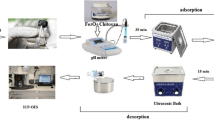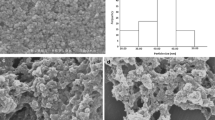Abstract
Diphenyl diselenide was immobilized on chitosan loaded with magnetite (Fe3O4) nanoparticles to give an efficient and cost-effective nanosorbent for the preconcentration of Pb(II), Cd(II), Ni(II) and Cu(II) ions by using effervescent salt-assisted dispersive magnetic micro solid-phase extraction (EA-DM-μSPE). The metal ions were desorbed from the sorbent with 3M nitric acid and then quantified via microflame AAS. The main parameters affecting the extraction were optimized using a one-at-a-time method. Under optimum condition, the limits of detection, linear dynamic ranges, and relative standard deviations (for n = 3) are as following: Pb(II): 2.0 ng·mL−1; 6.3–900 ng·mL−1; 1.5%. Cd(II): 0.15 ng·mL−1; 0.7–85 ng·mL−1, 3.2%; Ni(II): 1.6 ng·mL−1,.6.0–600. ng·mL−1, 4.1%; Cu(II): 1.2 ng·mL−1, 3.0–300 ng·mL−1, 2.2%. The nanosorbent can be reused at least 4 times.

Fe3O4-chitosan composite was modified with diphenyl diselenide as a sorbent for separation of metal ions by effervescent salt-assisted dispersive magnetic micro solid-phase extraction.



Similar content being viewed by others
References
Jin Z, Nie H, Yang Z, Zhang J, Liu Z, Xu X, Huang S (2012) Metal-free selenium doped carbon nanotube/graphene networks as a synergistically improved cathode catalyst for oxygen reduction reaction. Nanoscale 4(20):6455–6460
Gamage A, Shahidi F (2007) Use of chitosan for the removal of metal ion contaminants and proteins from water. Food Chem 104(3):989–996
Vold IM, Vårum KM, Guibal E, Smidsrød O (2003) Binding of ions to chitosan—selectivity studies. Carbohyd Polym 54(4):471–477
Kandile NG, Mohamed HM, Mohamed MI (2015) New heterocycle modified chitosan adsorbent for metal ions (II) removal from aqueous systems. Int J Biol Macromol 72:110–116
Liu L, Li C, Bao C, Jia Q, Xiao P, Liu X, Zhang Q (2012) Preparation and characterization of chitosan/graphene oxide composites for the adsorption of Au (III) and Pd (II). Talanta 93:350–357
Jayakumar R, Prabaharan M, Reis R, Mano J (2005) Graft copolymerized chitosan—present status and applications. Carbohyd Polym 62(2):142–158
Fahimirad B, Asghari A, Rajabi M (2017) A novel nanoadsorbent consisting of covalently functionalized melamine onto MWCNT/Fe3O4 nanoparticles for efficient microextraction of highly adverse metal ions from organic and inorganic vegetables: optimization by multivariate analysis. J Mol Liq
Fan H-L, Zhou S-F, Jiao W-Z, Qi G-S, Liu Y-Z (2017) Removal of heavy metal ions by magnetic chitosan nanoparticles prepared continuously via high-gravity reactive precipitation method. Carbohyd Polym 174:1192–1200
Ajmal M, Rao RA, Ahmad R, Ahmad J, Rao LA (2001) Removal and recovery of heavy metals from electroplating wastewater by using Kyanite as an adsorbent. J Hazard Mater 87(1–3):127–137
Zawisza B, Baranik A, Malicka E, Talik E, Sitko R (2016) Preconcentration of Fe (III), Co (II), Ni (II), Cu (II), Zn (II) and Pb (II) with ethylenediamine-modified graphene oxide. Micro Chim Acta 183(1):231–240
Shokrollahi A, Ghaedi M, Hossaini O, Khanjari N, Soylak M (2008) Cloud point extraction and flame atomic absorption spectrometry combination for copper (II) ion in environmental and biological samples. J Hazard Mater 160(2–3):435–440
Jha MK, Gupta D, Choubey PK, Kumar V, Jeong J, Lee J-c (2014) Solvent extraction of copper, zinc, cadmium and nickel from sulfate solution in mixer settler unit (MSU). Sep Purif Technol 122:119–127
Komjarova I, Blust R (2006) Comparison of liquid–liquid extraction, solid-phase extraction and co-precipitation preconcentration methods for the determination of cadmium, copper, nickel, lead and zinc in seawater. Anal Chim Acta 576(2):221–228
Karimi M, Dadfarnia S, Shabani AMH, Tamaddon F, Azadi D (2015) Deep eutectic liquid organic salt as a new solvent for liquid-phase microextraction and its application in ligandless extraction and preconcentraion of lead and cadmium in edible oils. Talanta 144:648–654
Tobiasz A, Walas S (2014) Solid-phase-extraction procedures for atomic spectrometry determination of copper. Trends Analyt Chem 62:106–122
Fahimirad B, Asghari A, Rajabi M (2017) Magnetic graphitic carbon nitride nanoparticles covalently modified with an ethylenediamine for dispersive solid-phase extraction of lead (II) and cadmium (II) prior to their quantitation by FAAS. Micro Chim Acta 184(8):3027–3035
Lasarte-Aragonés G, Lucena R, Cárdenas S, Valcárcel M (2011) Effervescence-assisted dispersive micro-solid phase extraction. J Chromatogr A 1218(51):9128–9134
Daşbaşı T, Saçmacı Ş, Ülgen A, Kartal Ş (2016) Determination of some metal ions in various meat and baby food samples by atomic spectrometry. Food Chem 197:107–113
Rajabi M, Rezaie A, Ghaedi M (2015) Simultaneous extraction and preconcentration of some metal ions using eucalyptus-wood based activated carbon modified with silver hydroxide nanoparticles and a chelating agent: optimization by an experimental design. RSC Adv 5(108):89204–89217
Rangraz Y, Nemati F, Elhampour A (2018) Magnetic chitosan composite as a green support for anchoring diphenyl diselenide as a biocatalyst for the oxidation of sulfides. Int J Biol Macromol 117:820–830
Gupta A, Chauhan VS, Sankararamakrishnan N (2009) Preparation and evaluation of iron–chitosan composites for removal of As (III) and As (V) from arsenic contaminated real life groundwater. Water Res 43(15):3862–3870
Duran C, Senturk HB, Elci L, Soylak M, Tufekci M (2009) Simultaneous preconcentration of Co (II), Ni (II), Cu (II), and Cd (II) from environmental samples on Amberlite XAD-2000 column and determination by FAAS. J Hazard Mater 162(1):292–299
Taghizadeh M, Asgharinezhad AA, Pooladi M, Barzin M, Abbaszadeh A, Tadjarodi A (2013) A novel magnetic metal organic framework nanocomposite for extraction and preconcentration of heavy metal ions, and its optimization via experimental design methodology. Micro Chim Acta 180(11–12):1073–1084
Alothman ZA, Yilmaz E, Habila M, Soylak M (2015) Solid phase extraction of metal ions in environmental samples on 1-(2-pyridylazo)-2-naphthol impregnated activated carbon cloth. Ecotoxicol Environ Saf 112:74–79
Yilmaz E, Soylak M (2014) Solid phase extraction of cd, Pb, Ni, cu, and Zn in environmental samples on multiwalled carbon nanotubes. Environ Monit Assess 186(9):5461–5468
Mohammadi S, Afzali D, Pourtalebi D (2010) Flame atomic absorption spectrometric determination of trace amounts of lead, cadmium and nickel in different matrixes after solid phase extraction on modified multiwalled carbon nanotubes. Cent Eur J Chem 8(3):662–668
Acknowledgments
The authors would like to thank the Semnan University Research Council for the financial support of this work.
Author information
Authors and Affiliations
Corresponding author
Ethics declarations
The author(s) declare that they have no competing interests.
Additional information
Publisher’s Note
Springer Nature remains neutral with regard to jurisdictional claims in published maps and institutional affiliations.
Electronic supplementary material
ESM 1
(DOCX 482 kb)
Rights and permissions
About this article
Cite this article
Fahimirad, B., Rangraz, Y., Elhampour, A. et al. Diphenyl diselenide grafted onto a Fe3O4-chitosan composite as a new nanosorbent for separation of metal ions by effervescent salt-assisted dispersive magnetic micro solid-phase extraction. Microchim Acta 185, 560 (2018). https://doi.org/10.1007/s00604-018-3094-x
Received:
Accepted:
Published:
DOI: https://doi.org/10.1007/s00604-018-3094-x




